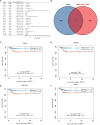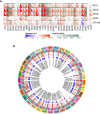Comprehensive Pan-Cancer Analysis and the Regulatory Mechanism of ASF1B, a Gene Associated With Thyroid Cancer Prognosis in the Tumor Micro-Environment
- PMID: 34490109
- PMCID: PMC8417739
- DOI: 10.3389/fonc.2021.711756
Comprehensive Pan-Cancer Analysis and the Regulatory Mechanism of ASF1B, a Gene Associated With Thyroid Cancer Prognosis in the Tumor Micro-Environment
Abstract
Background: The incidence of thyroid cancer, whose local recurrence and metastasis lead to death, has always been high and the pathogenesis of papillary thyroid carcinoma (PTC) has not been clearly elucidated. Therefore, the research for more accurate prognosis-related predictive biomarkers is imminent, and a key gene can often be a prognostic marker for multiple tumors.
Methods: Gene expression profiles of various cancers in the TCGA and GTEx databases were downloaded, and genes significantly associated with the prognosis of THCA were identified by combining differential analysis with survival analysis. Then, a series of bioinformatics tools and methods were used to analyze the expression of the gene in each cancer and the correlation of each expression with prognosis, tumor immune microenvironment, immune neoantigens, immune checkpoints, DNA repair genes, and methyltransferases respectively. The possible biological mechanisms were also investigated by GSEA enrichment analysis.
Results: 656 differentially expressed genes were identified from two datasets and 960 DEGs that were associated with disease-free survival in THCA patients were screened via survival analysis. The former and the latter were crossed to obtain 7 key genes, and the gene with the highest risk factor, ASF1B, was selected for this study. Differential analysis of multiple databases showed that ASF1B was commonly and highly expressed in pan-cancer. Survival analysis showed that high ASF1B expression was significantly associated with poor patient prognosis in multiple cancers. In addition, ASF1B expression levels were found to be associated with tumor immune infiltration in THCA, KIRC, LGG, and LIHC, and with tumor microenvironment in BRCA, LUSC, STAD, UCEC, and KIRC. Further analysis of the relationship between ASF1B expression and immune checker gene expression suggested that ASF1B may regulate tumor immune patterns in most tumors by regulating the expression levels of specific immune checker genes. Finally, GSEA enrichment analysis showed that ASF1B high expression was mainly enriched in cell cycle, MTORC1 signaling system, E2F targets, and G2M checkpoints pathways.
Conclusions: ASF1B may be an independent prognostic marker for predicting the prognosis of THCA patients. The pan-cancer analysis suggested that ASF1B may play an important role in the tumor micro-environment and tumor immunity and it has the potential of serving as a predictive biomarker for multiple cancers.
Keywords: anti-silencing function protein 1 homolog B (ASF1B); pan-cancer; prognosis; thyroid cancer; tumor immune micro-environment.
Copyright © 2021 Ma, Han and Lu.
Conflict of interest statement
The authors declare that the research was conducted in the absence of any commercial or financial relationships that could be construed as a potential conflict of interest.
Figures








Similar articles
-
Identification of SHCBP1 as a potential biomarker involving diagnosis, prognosis, and tumor immune microenvironment across multiple cancers.Comput Struct Biotechnol J. 2022 Jun 18;20:3106-3119. doi: 10.1016/j.csbj.2022.06.039. eCollection 2022. Comput Struct Biotechnol J. 2022. PMID: 35782736 Free PMC article.
-
Identifies microtubule-binding protein CSPP1 as a novel cancer biomarker associated with ferroptosis and tumor microenvironment.Comput Struct Biotechnol J. 2022 Jun 24;20:3322-3335. doi: 10.1016/j.csbj.2022.06.046. eCollection 2022. Comput Struct Biotechnol J. 2022. PMID: 35832625 Free PMC article.
-
Pan-Cancer Analysis Revealed SRSF9 as a New Biomarker for Prognosis and Immunotherapy.J Oncol. 2022 Jan 12;2022:3477148. doi: 10.1155/2022/3477148. eCollection 2022. J Oncol. 2022. PMID: 35069733 Free PMC article.
-
Identification of ASF1B as a prognostic marker for liver cancer by meta-analysis and its immune value revealed by a comprehensive pan-cancer analysis of 33 human cancers.Prz Gastroenterol. 2023;18(3):249-265. doi: 10.5114/pg.2023.124423. Epub 2023 Jan 23. Prz Gastroenterol. 2023. PMID: 37937108 Free PMC article. Review.
-
A Pan-Cancer Analysis Reveals the Prognostic and Immunotherapeutic Value of Stanniocalcin-2 (STC2).Front Genet. 2022 Jul 22;13:927046. doi: 10.3389/fgene.2022.927046. eCollection 2022. Front Genet. 2022. PMID: 35937984 Free PMC article. Review.
Cited by
-
WD repeat domain 76 predicts poor prognosis in lower grade glioma and provides an original target for immunotherapy.Eur J Med Res. 2024 Jan 3;29(1):13. doi: 10.1186/s40001-023-01605-6. Eur J Med Res. 2024. PMID: 38173030 Free PMC article.
-
Prediction of the Aggressive Clinical Course of Papillary Thyroid Carcinoma Based on Fine Needle Aspiration Biopsy Molecular Testing.Int J Mol Sci. 2024 Jun 28;25(13):7090. doi: 10.3390/ijms25137090. Int J Mol Sci. 2024. PMID: 39000197 Free PMC article.
-
Comprehensive analysis of INTS family related to expression, prognosis, diagnosis and immune features in hepatocellular carcinoma.Heliyon. 2024 Apr 24;10(9):e30244. doi: 10.1016/j.heliyon.2024.e30244. eCollection 2024 May 15. Heliyon. 2024. PMID: 38720706 Free PMC article.
-
miR-24-3p Regulates Epithelial-Mesenchymal Transition and the Malignant Phenotype of Pancreatic Adenocarcinoma by Regulating ASF1B Expression.Biochem Genet. 2023 Apr;61(2):742-761. doi: 10.1007/s10528-022-10278-5. Epub 2022 Sep 17. Biochem Genet. 2023. PMID: 36114946 Free PMC article.
-
Carcinogenic Role and Clinical Significance of Histone H3-H4 Chaperone Anti-silencing Function 1 B (ASF1B) in Lung Adenocarcinoma.J Cancer. 2024 Jan 1;15(1):218-231. doi: 10.7150/jca.88777. eCollection 2024. J Cancer. 2024. PMID: 38164276 Free PMC article.
References
-
- Amin MB, Greene FL, Edge SB, Compton CC, Gershenwald JE, Brookland RK, et al. . The Eighth Edition AJCC Cancer Staging Manual: Continuing to Build a Bridge From a Population-Based to a More “Personalized” Approach to Cancer Staging. CA: Cancer J Clin (2017) 67(2):93–9. 10.3322/caac.21388 - DOI - PubMed
LinkOut - more resources
Full Text Sources
Research Materials
Miscellaneous

